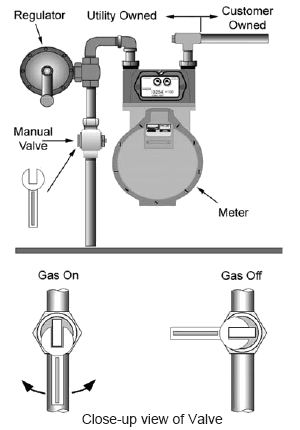The Seven Steps
Gas Safety
The Problem
Natural gas piping and appliances can be damaged during earthquakes, causing gas leaks. If ignited, this can result in fires which can burn part of, or, the entire building. About one in four fires after an earthquake is related to natural gas leaks. Gas leaks after an earthquake are more likely if:
- There are structural weaknesses
- Gas appliances are not anchored
- Flexible pipe connections are not used.
The primary concern is property loss from fire damage. The potential for life loss is limited since most commercial properties have several safe exits.
How to Identify
- Examine all natural gas appliances (water heaters, dryers, stoves, ovens, furnaces) to see if they are anchored to the floor or walls, and have flexible pipe connections.
Plan Ahead
- Locate your gas meter outside your building.
- Identify the exact location of the shutoff valve and make sure that you have access to it.
- Make sure you have a wrench that is readily available to turn off the gas when needed.
Manual Gas Shutoff
- The most cost-effective way to manage the risk from natural gas is to know how and when to manually shut off the gas.
- Use the wrench to turn off the manual valve located at the gas meter (See drawing above).
- Shut off your gas only if you:
- Smell gas
- Hear gas escaping
- Suspect a broken gas pipe, appliance, vent, or flue.
- Manually shutting off gas to commercial and manufacturing buildings should be included in emergency response procedures for trained maintenance personnel.
Remember
- Once the gas has been shutoff, service can be restored only by utility personnel or qualified plumbers.
- Restoration of gas service by qualified persons should include the inspection and repair of damaged systems.
- High demands for qualified personnel after an earthquake can lead to substantial delays in restoring natural gas service.
Resources
- Seismic Gas Shut-Off Valve Requirements in Los Angeles, City of Los Angeles, Department of Building & Safety, Information Bulletin #P/PC 2002-001, April 30, 2003.
- Improving Natural Gas Safety in Earthquakes, California Seismic Safety Commission, Publication #CSSC-02-03, July 2002.
- Gas Shutoff Valve Certification Program, Division of the State Architect.
Automatic Gas Shutoff Options
There are a variety of automatic gas shut-off valves available. These cost more than manual shutoff valves and may provide additional safety but may also have some disadvantages including the potential for delays in service restoration and shutoffs when hazardous conditions may not exist.The types of valves available include:
- Earthquake shake-actuated valves
- Excess flow valves
- Methane detectors
- Hybrid systems
- Others
These can be installed on the “customer owned” side of the gas meter. Consult your local Building Department because:
- Some installations will require building permits.
- Some local jurisdictions have adopted ordinances requiring automatic gas shutoff devices at the time of sale or during significant renovations.





